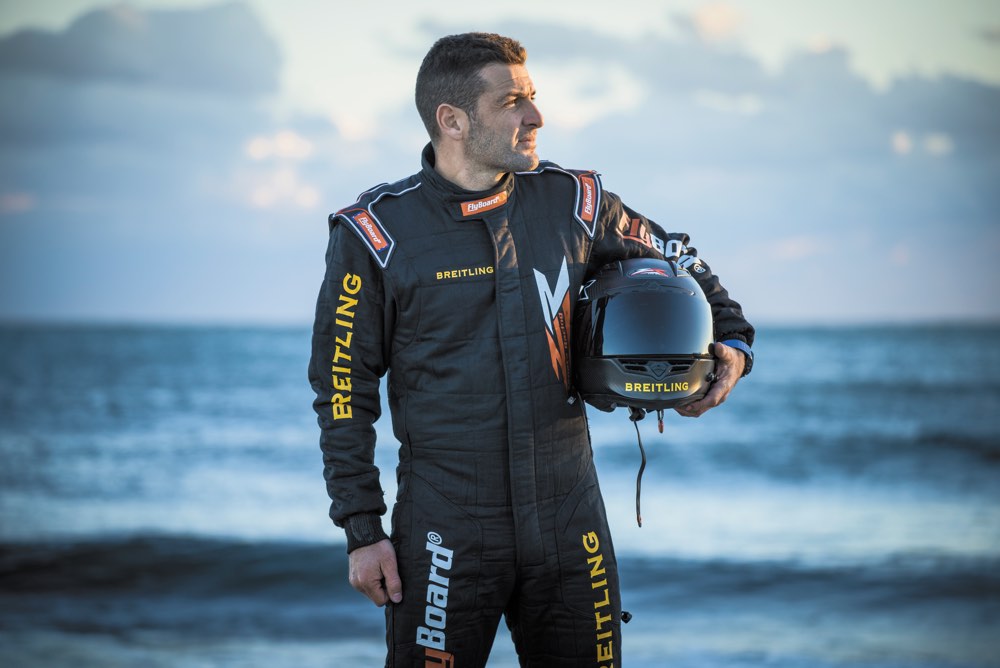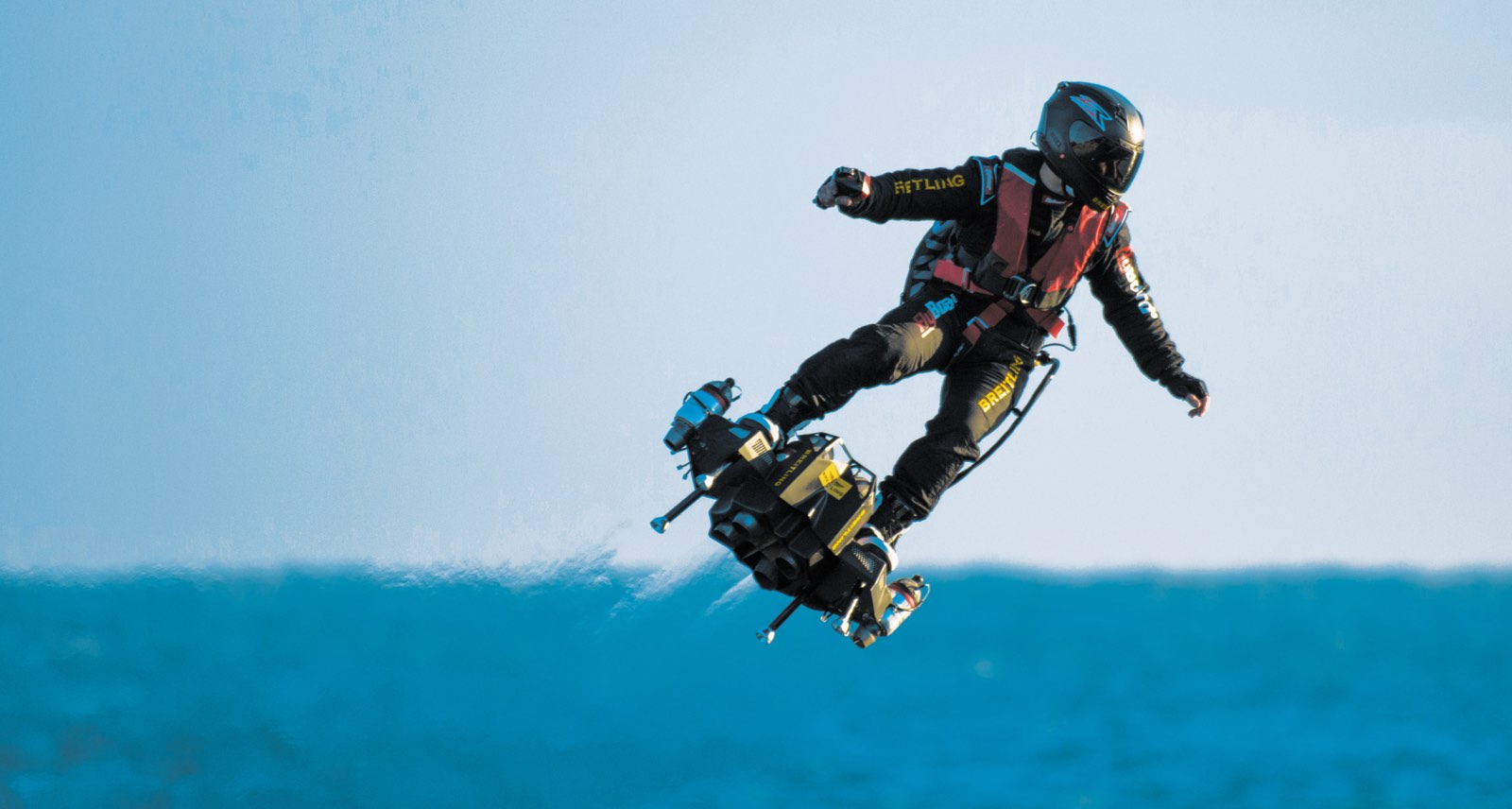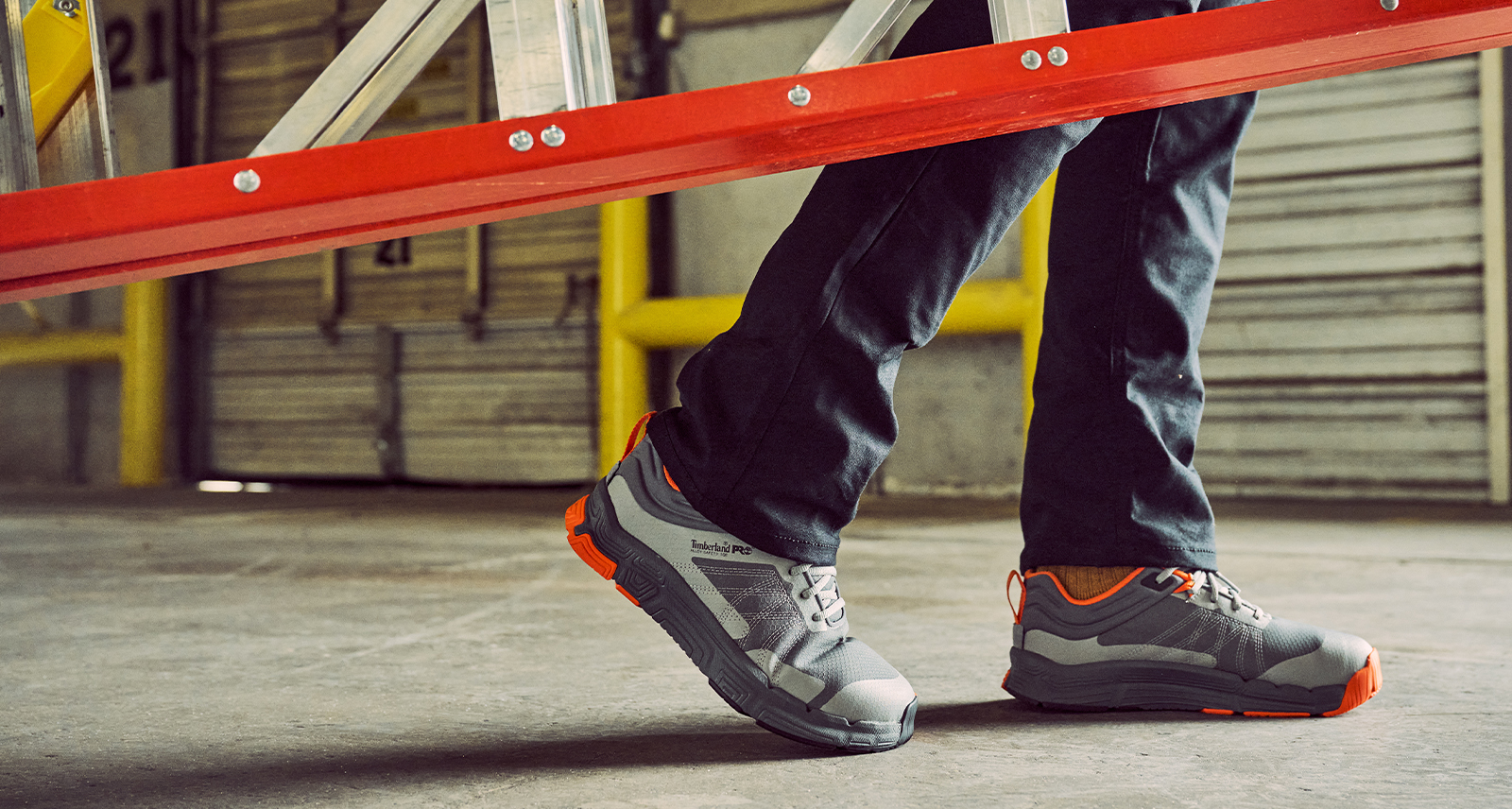Franky Zapata’s Real Life Hoverboard Sent Social Media Ablaze. Then the American Military Called
It’s a strange time for pioneers. The competing powers of hype and scepticism are both at world-conquering highs. Consumers, citizens, whatever you want to call the rest of us, we say we want groundbreaking ideas, that we’re hungry for disruptors to change the world. But, like the plucky protagonist in a romantic comedy, we’ve been burned before.
On April 9, 2016 Franky Zapata and his crew uploaded a video to YouTube of a test flight for the Flyboard Air, a single-person aircraft that looks very much like the glider the Green Goblin rode to terrorize Spider-Man. Zapata, who first made a name for himself in the niche world of jet-ski racing, had made waves (literally and figuratively) a few years prior by inventing the FlyBoard. You’ve seen it: it’s that jet pack that sucks in water and then uses it to blast its user up and out over the water like a dolphin on gamma rays.

But this was different. The FlyBoard Air didn’t use water for propulsion. It was like a drone you stood on: four small engines, steered by balance and wi-fi controls, with fuel fuel through a camelback pouch Zapata wore on his back. He hovered over the water as a safety precaution, not out of necessity. The footage looks like something out of a science-fiction movie — the kind of thing you accept without question if you’re in a future world, but shockingly out of place in our reality.
As the footage spread across the Internet, people were sceptical. The Internet — fully aware of what can be done with CGI — was sure this man flying high above us like a Jack Kirby character, was just a hoax. But it wasn’t. It was the first images of a pioneer, changing how men conquer the skies.
“During my first flight, many things crossed my mind,” Zapata recalls. “The most dominant feeling was concentration. Every single detail became of major importance and there was a lot of tension. But at last what a great feeling to be able to take off!”
The world has been waiting for some enterprising scientist to make and market a legitimate hoverboard since at least 1989, when Robert Zemeckis, the director of the hoverboard propaganda film Back to the Future Part II, claimed the floating skateboard did in fact exist but was too dangerous to sell. Since then, there has mostly been a series of hoaxes and PR stunts. Lexus made one by burying a magnetic track under the ground, though it was never meant for consumers. And of course, out of a kind of collective laziness, we call those two-wheeled boards — which look more like Segways without handles — hoverboards. These are all misnomers. Zapata’s invention — though he used it on April 30, 2016, to break the world record for furthest distance travelled on a hoverboard — isn’t exactly a hoverboard either. The Flyboard Air well, flies. It soars.
But the references to fictional technology are apt. In fact, it’s almost impossible to talk about Franky Zapata without using comic book comparisons. We’re used to innovators looking a certain way. They come out of Silicon Valley, wearing hoodies and thick-frame glasses. Or, if they’re older, they hide their genius and net worth under Indiana Jones jackets and wavy, rich-man-hair. Or, they look like Elon Musk.
We’re not used to hands-on inventors like this, who tinker in their own shop, then risk their own life to test their inventions. That’s like something Howard Hughes would do. Or Tony Stark or Bruce Wayne. To be this kind of success is to be a member of a small club, with millions of backyard amateurs waiting to be let in, inclusion into which depends on the number of slashes necessary to describe your role. Inventor/jet ski racer/test pilot/businessman/ and so on. “When your company is growing like this, all your functions and multitasking abilities come into play, and become crucial,” Zapata says. “However, it is in my workshop that I take most of my pleasure, working and innovating.”
Because there are so few pioneers like Zapata — at least non-fictional ones — there’s no predictable path to follow. That means that his personal history is neither surprising, nor common. It just is. “I had a very normal family life,” he says. “My father ran a construction firm and my mother dedicated herself to my education, far away from the world of extreme sports and the workshops where I am innovating on a daily basis.”
But at an early age he did become fascinated with water-sports. He became a competitive jet-ski racer. That taught him the mechanics of hydro-propulsion. Once he felt that power on the water, he wanted to feel it above the water, too. Far above it. “I never really went through setbacks in my life even though I faced some hard blows,” he says.
So, first came the Flyboard. And then the buzz. And then the Flyboard Air “To be honest, I was far from thinking it would create such a buzz around this machine by uploading a test video on social media. But we can really feel the impact of it while being in contact with the public.”
But, now Zapata has been in contact with more than just the public. He’s caught the eye — and the imagination — of global brands who share his pioneering spirit.
“As the official supplier to world aviation for over a century, Breitling’s intention is to foster the innovation and sense of adventure that drives aeronautics to push the boundaries of feasibility. When Breitling and Franky Zapata first connected, we knew it was a great fit,” says Jean-Paul Girardin, Vice-President of Breitling. “The Flyboard Air project radiates the spirit of daring invention that has always characterized aviation since the time of the very first ‘magnificent men in their flying machines.’”
But brands aren’t the only ones. Last spring it was reported that the American military had started talking to Zapata, looking for ways to harness his technology for defense purposes. Which is exactly what you’d expect. If Tony Stark or Bruce Wayne were real, they’d be taking meetings with generals, too.
It’s a crazy time to be a pioneer. And it’s only going to get crazier.










